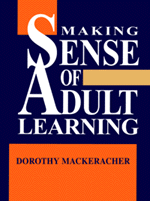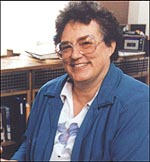| By Dorothy MacKeracher University of New Brunswick Fredericton, NB |
 |
| By Dorothy MacKeracher University of New Brunswick Fredericton, NB |
 |
|
My understanding of learning is based on a learner-centered approach to teaching and learning rather than a teacher-centered approach. The more we know about the process of learning and the unique strategies used by individual learners to carry out their learning activities, the more effectively we can design appropriate activities and resources to facilitate that learning. The teacher-centered approach assumes that learning follows and adapts to whatever teaching strategies are used. Learning is assumed to respond to teaching. If teaching is based on talking or on directing and controlling activities, then learning is based on listening, following directions and being controlled. The learner-centered approach I espouse begins with a dialogue in which the teacher listens to the learners to gain an understanding of their preferred learning strategies and very quickly adapts teaching strategies to accommodate those preferences. Teaching responds to learning rather than controlling and directing it. This approach to teaching is difficult. It requires a complex understanding of likely preferences in learning activities or learning styles, a knowledge of different teaching techniques and their application, and a willingness to use a wide range of different teaching activities. In group settings I have found that, while I cannot tailor my teaching to the unique learning styles of every individual in the group, I can use many different approaches so that individuals will get some time doing what they like best. When working with individual learners, however, I attempt to develop strategies which best suit their individual needs and preferred learning styles. In ideal teaching-learning interactions, learning originates from within the learner as a natural evolving process which emerges from the learner’s need or desire to interact with the environment. One of the most fundamental things we do as human beings is to organize our life experiences by making sense of them and giving them meaning. Learning activities are designed to help us:
Current theories on brain function suggest that the human brain needs and is designed to learn throughout life. The brain’s need for activity can be reduced, and the learner can be demotivated from learning, through such conditions as: poor health, poor nutrition, substance abuse, emotional abuse, information overload, to name but a few. Learning occurs when the brain extracts sets of meaningful patterns from the buzzing, blooming confusion of daily life. These patterns are then organized into meaning perspectives and strategies for doing more learning. In this view of learning, four conditions are necessary:
The book, Making Sense of Adult Learning, discusses adult learning from emotional, cognitive (mental), social, physical and spiritual perspectives; describes selected characteristics of adult learners, and considers various learning and facilitating styles. |
 |
Dr. Dorothy MacKeracher UNB To Order, please contact: Culture Concepts, Inc., 69 Ashmount Crescent, Toronto, ON, M9R 1C9. 1-800-478-4300. |
 |
|
|
Adults want learning to be meaningful. Reference: Caffarella, R.S., Planning Programs for Adult Learners. San Francisco:Jossey-Bass, 1994. |
| Back | Next Page |